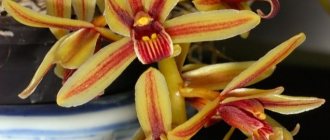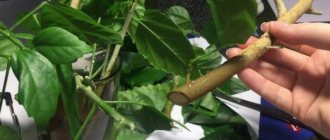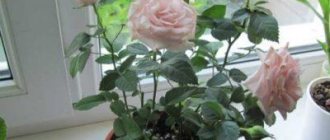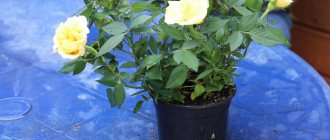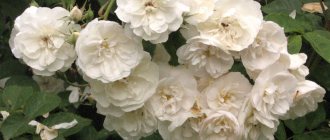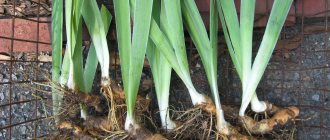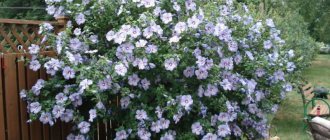Description and features
Types of dwarf crops
Bengal
This species was brought to Europe from Bengal, which is why it got its name. The Bengal rose bush grows 40-50cm in height. The leaves are pointed, dark green. The shape of the flowers is slightly flattened, and their color can be red, white or pink.
Teahouse
Tea rose was brought from China. Its aroma is reminiscent of tea, which is why it got its name. There is another version - its blossoming flowers resemble the shape of a Chinese tea bowl. The bush of this rose grows 50cm. The leaves are dark green. have an oval shape. The flowers are double, large, and their colors can be very different.
This species has a long flowering period. This is the only type of rose from which tea can be made.
Mix
The bush of this interesting type of dwarf roses looks like a ready-made bouquet. They are not classified into varieties for sale, which is why they are called that. It comes in miniature (up to 30cm) and patio (up to 50cm). She comes in a variety of colors. Flowers are medium sized, flattened.
You can learn more about the varieties of the lovely mixed rose and the features of its cultivation here.
Polyanthus
It is also called multi-flowered. It can reach a height of up to 50 cm. The flowers are small, double or semi-double, and have no scent. The flowers are collected in inflorescences and are distinguished by a variety of color shades.
Botanical description
Belongs to the Rosaceae family. Most often, dwarf roses are evergreen multi-stemmed shrubs, the height of which varies from 10 to 50 cm. The leaves are alternate, compound, with stipules, each of which contains 5-13 oval or round leaflets. The surface of the leaves can be shiny or matte, their color is usually dark green.
The stems of most types of dwarf roses are covered with thorns. The diameter of flowers can be from 1 to 5 cm. Flowers can be single, double or semi-double. Their shape can be spherical, flat, goblet or cupped. The shape of the petals can also be different: they can be bent, flat or wavy. Dwarf roses can be of all colors and shades, there are not only blue ones.
Peculiarities
The main feature of miniature roses is their small size. Another feature is that this species is suitable for growing both indoors and outdoors. The size of mini roses makes it convenient to grow them at home, and due to their frost resistance, they are also suitable for open ground.
Another distinctive feature of these roses is that they make excellent decorations for borders, verandas and attics, again due to their small size.
Pros and cons of growing miniature species in pots at home
The benefits of growing miniature roses at home include:
- decorativeness;
- long flowering period;
- variety of colors and shades;
- resistance to diseases and pests.
The disadvantages of growing mini roses at home include:
- dwarf roses are more whimsical than ordinary ones;
- small sizes (not everyone likes this).
Origin story
The history of the origin of dwarf roses is not entirely clear. You can find several versions of the origin of the species in different sources: some of them say that the flower’s homeland is Europe, others believe that it was brought from Southeast Asia. But according to the classical version, it is believed that the miniature rose was brought from China.
What kind of care do mini roses in pots require and how to properly grow them at home?
The dwarf rose is an elegant miniature plant that will be an ideal decoration for your home or alpine garden. Unlike a regular rose, a dwarf rose is easier to care for; it blooms all season long.
What are the features of this interesting species? How to properly care for it? What types of dwarf roses are there? You will find answers to these and other questions in our article.
Content requirements
Place
When growing a mini-rose, you must provide it with good air exchange, so the best place for its location would be a balcony. You can put a pot of roses on the windowsill, but you will need to open the window often. In summer you can take the flower with you to the dacha.
Temperature
During flowering, which occurs in the summer, the plant needs fresh air, so try to place the flower on a balcony or loggia whenever possible.
Remember that roses do not like extreme heat, so try not to let the soil overheat. Choose light-colored pots, and in the hot season, wrap the flower container with reflective material.
Room temperature will be ideal for potted roses. Cold air is also harmful to it, so make sure that on cold days there is no blowing from the windows, and if you use a fan or air conditioner, place it away from the plant.
Humidity
During the development and flowering of a rose, it is necessary to spray it. You can give her a warm shower once a week.
In any case, you cannot ignore moisture, as this can lead to drying out of the leaves or, even worse, the appearance of pests (more on them below).
Lighting
The dwarf rose is a light-loving plant, therefore, it needs good lighting. But the scorching summer sun can damage the flower, so try to protect it from direct sunlight, especially at midday. In the morning and evening hours, the sun is not dangerous for the rose.
Lighting, temperature and humidity
Like garden roses, their dwarf relatives love good lighting, but not the south side, where the bush will quickly bloom and the leaves will fade. Such windows should be shaded in summer, and if possible, the flowerpot should be placed in the southwest. But in winter, when daylight hours are short, the rose needs additional lighting with lamps.
In order for the bush to form evenly, it is recommended to turn it towards the sun as the branches are stretched.
Comfortable temperature for a dwarf rose depends on the time of year and period of development:
- in spring and summer – no higher than 25 degrees Celsius;
- from mid-autumn to the end of winter - from 5 to 8 degrees Celsius.
Dry indoor air is detrimental to roses, so you should spray the bushes daily and place a container of water nearby.
Growing and proper care of flowers in pots
Landing
Landing is carried out according to the following rules:
- Prepare a container.
- If the container has already been used, clean it with a brush, do not use detergents.
- You need to make good drainage. For this you can use expanded clay: if there is a hole in the pot, the layer of expanded clay should not be more than 1 cm, but if there are no holes, then at least 3 cm.
- The soil needs to be nutritious and breathable. You can buy soil in the store or prepare it yourself by mixing turf, humus and sand in a ratio of 4:4:1.
Watering
In summer, the rose needs abundant and regular watering. Do not allow the soil to dry out. But if the summer is cold, then do not overwater the plant; for it, an excess of moisture is worse than a lack of it. After flowering has finished, watering should be stopped. During the wintering period, you need to water the dwarf rose, but very rarely, 1-2 times per period is enough.
Watering is resumed with the appearance of buds on the flower and increases as it grows and new leaves appear.
Water for irrigation should be warm, not lower than room temperature.
Top dressing
It is necessary to fertilize a rose only during the period of bud setting and flowering. Once every 10 days, feed your flower with a special fertilizer for flowering plants. By the end of flowering (beginning of autumn), fertilizing should be stopped.
Trimming
Pruning should be done after the plant has finished flowering, but spring pruning can also be done. Leave 4-5 buds on each branch and remove the rest (except leaves). Pruning the plant is the key to abundant flowering; it must be done.
Transfer
Potted roses do not like replanting, so it is carried out only if the pot is small.
The transplant is carried out as follows:
- We choose a larger container, clean and rinse it.
- The plant has very delicate roots that are very easy to damage, so it is better to soak the flower pot for half an hour. This way the earthen lump will be better separated from the pot.
- We transfer the earthen lump into a new container, sprinkle it with earth and compact it well around the plant.
It is not recommended to water the rose after transplantation. Place it in a dark place for a week, then put it back in a lighted place.
Prevention from pests and diseases
In order to prevent a flower from becoming infected, you need to:
- Make sure that the soil does not become waterlogged.
- Maintain sufficient air humidity.
- Protect the plant from drafts.
- Keep the flower away from direct sunlight.
Also, after purchasing a plant, you can treat the rose with Fitoverm, which will provide protection against pests.
Propagation of indoor crops
Dwarf roses are propagated by cuttings. They do this as follows:
- Using a knife, which must be treated with a solution of potassium permanganate, cut a stalk 10 cm long.
- The cut should be made directly under the bud, preferably oblique.
- Make the upper cut 5mm above the kidney.
- Remove leaves from the bottom of the cutting.
- Place the cuttings in water for 10 hours.
- Plant the cuttings in the prepared mixture of sand and peat.
- Heavy watering is not necessary, otherwise the cuttings may rot.
- Ensure a stable temperature of at least 18 degrees and protect cuttings from exposure to direct sunlight.
Reproduction of indoor roses
Indoor roses are propagated by cuttings. For this purpose, stems of purchased roses from the store or adult bushes during the growing season are suitable. Cuttings can be done in a greenhouse, at home, and even in open ground. The best time for this process is spring and summer. However, even in winter, provided that additional lighting is used, it is quite possible to germinate a cutting of a plant you like.
Preparing cuttings
To obtain shoots, parts of the stem with several buds are suitable - 2-4 buds are enough. Cuttings should be taken from the middle, mature part of the stem with young bark and green healthy buds. A branch is cut from below right below the lower bud, and a couple of cm are removed from the upper bud.
The roots emerge from the lower bud placed in a moist environment. The most common methods of root formation are in water and in substrate.
Recently, gardeners are increasingly resorting to cuttings in potato tubers. The plant feeds on moisture from the root crop and feels very comfortable as long as it does not have large roots. We make a hole in the potato, place a cutting in it so that the two lower buds are inside, and plant it in the ground - open ground or a pot.
Cuttings in water
Most often cuttings occur in water. We place the branch in the container so that the lower buds are in the water and make sure that the liquid level does not decrease. After a few weeks, small roots will form and the plant can be planted in the ground. The disadvantage of this method is that the cuttings may rot in water. In addition, rose roots are very delicate and often suffer during replanting.
Cuttings in the substrate
If you root the cuttings directly in the soil, the described problems can be avoided. Rooted plants are transplanted into a flowerbed or pot along with a lump of soil. This avoids damage. Suitable planting materials include peat, sphagnum moss, and coconut substrate. Cuttings can be rooted both in separate pots and in a common box.
Before planting, it is necessary to dip the prepared cuttings in a special product that provokes rapid growth of root formation. Plant the branch on a slope, deepening a couple of lower buds. It is necessary to water the plant and cover it. For planting, you can take a glass or plastic jar, or just a plastic bag. The appearance of the first leaves indicates the formation of roots and signals that it is time to plant the plant.
Diseases and pests
Home roses can be affected by diseases and pests such as:
- Chlorosis. The appearance of this scourge can be recognized by yellowed leaves. Iron chelate effectively combats chlorosis.
- Powdery mildew. Its appearance is indicated by white spots on the leaves and stems of the plant. Fungicides are used for treatment.
- Spider mite. This pest leaves a thin web between the leaves. To combat it, the drugs Fitoverm and Apollo are used.
- Thrips and aphids. Deformation of the leaves and flowers indicates that the plant is infected by these pests. For treatment, insecticides for indoor plants are used.
How to care at home?
- Conditions of detention. To successfully grow a mini rose, you need to choose the right place, observe temperature, humidity and lighting.
- Place. A mini rose will require fresh air, so it is best to place it on the balcony. In the summer you can take the flower to the country house, but only with timely care.
- Temperature.
In winter, the rose enters a dormant period, so you need to maintain a temperature of 10-12 degrees Celsius. It is best to place the plant on a glassed-in loggia or balcony. If it is not possible to keep the rose at a low temperature, then it should be protected as much as possible from radiators and dry air. - Humidity. Indoor mini-roses require high air humidity. If you keep them on the balcony or in the garden, then no additional moisture is required. In winter, when the rose is grown at home, place the pot on a tray with wet pebbles.
Errors, consequences and their correction
Problems when growing mini roses at home can also arise due to improper care. What problems could these be?
- The plant does not develop or grow. The cause may be poor nutrition. To eliminate the problem, you need to regularly feed the flower.
- Leaves are falling. The reason is increased soil acidity. The problem can be solved by liming the soil.
- The leaves turn yellow and wither. Have you noticed this problem in your plant? This means he doesn't have enough light! Choose a well-lit area, and use additional lighting in the form of lamps in winter.
- The rose doesn't bloom. The fact is that you haven’t replanted your rose for a long time! Although she doesn't like it, this procedure needs to be done every 2 years.
A rose bush can be a wonderful decoration not only in the garden, but also in the house. On our website you will find articles about such types of indoor roses as Cordana and learn how to grow a bush rose in a pot.
A miniature rose is a great option for decorating your home. The variety of colors and types allows you to make a choice among its many varieties. Of course, it is quite difficult to care for it, but the result of your labors will not be long in coming - your flower will delight you with its flowering for a long time.
What kind of soil does a dwarf rose like?
In principle, the first two weeks after purchasing a flower there is no need to replant it. You should give the rose time to get used to the new, home climate. Some flower growers generally do not advise replanting a purchased plant until flowering ends or until it “grows” out of the old flowerpot. But if there is a need for urgent soil replacement or transshipment, this must be done after the rose has adapted.
In the future, the dwarf rose should be replanted in spring or late summer as the bush grows, choosing a pot 2-3 cm wider and 5 cm higher than the previous one.
The soil can be purchased at the store (ready-made substrate), or you can make it yourself by mixing:
- 1 part of the land from the garden;
- 2 parts each of humus and peat;
- a handful of coarse sand.

